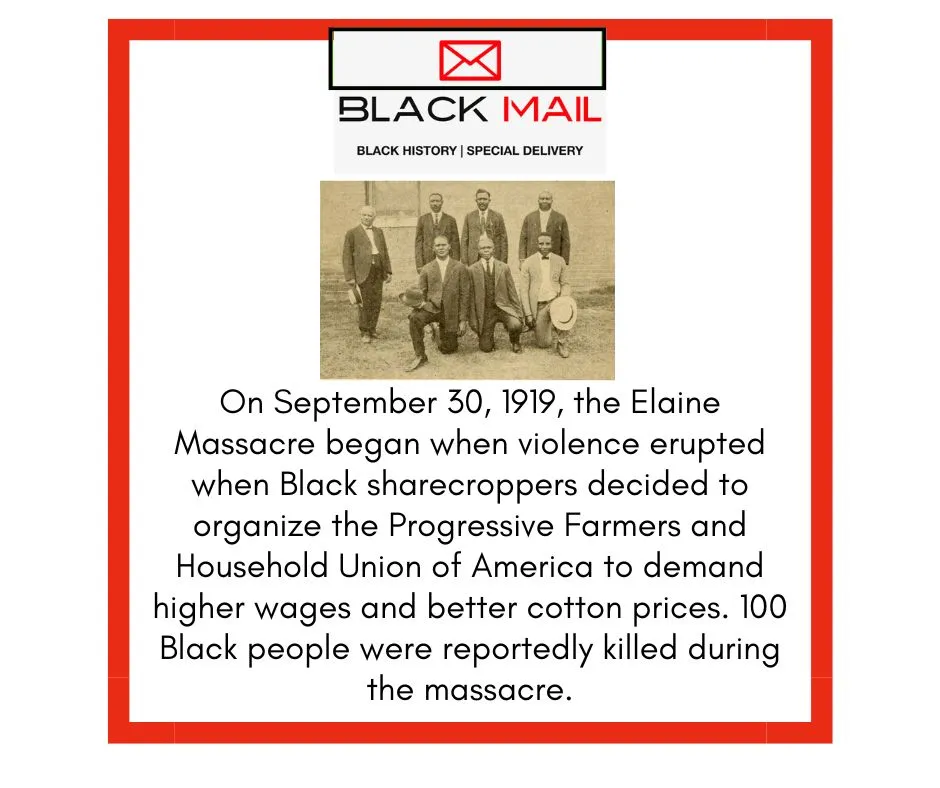Welcome to Black Mail, where we bring you Black History—Special Delivery!
The 1919 Elaine Massacre took place in Elaine, Arkansas. One of the deadliest racial lynchings in U.S. history, the massacre began when black sharecroppers formed the Progressive Farmers and Household Union of America to demand higher wages and better cotton prices. Even with cotton prices soaring exponentially, black sharecroppers were still being paid low wages. The union planned to have white attorney Ulysses Branton represent them. Many of the sharecroppers were also World War One veterans who had returned from the war, expecting that their military service would result in better treatment. They were wrong.
Angered by their organizing, news of the union meeting escalated racial tensions in the Phillips County community. Aware of the possibility of violence, the Black sharecroppers had armed guards standing watch during their late-night meeting. When a group of white people from the Missouri-Pacific Railroad attempted to disrupt the union meeting, the Black sharecroppers standing guard held them back, and violence quickly erupted. Over the next 72 hours, White mobs attacked the area’s Black residents, vandalizing properties, stealing their food and cotton, and burning their homes and businesses. Lies quickly spread that the Black sharecroppers had started a “negro insurrection.” The governor of Arkansas dispatched 500 troops to the area who, by many accounts, further perpetuated the violence. In one interaction, a group of Black veterans seeking support from the military were gunned down as they approached troops seeking help. Many black residents fled the area. Official reports documented that only two black residents died. Historians now estimate that over 100 Black people were killed, with some believing up to 800 black residents may have lost their lives.
Known as Red Summer, the summer of 1919 was a time of unprecedented racial violence and lynching The Elaine Massacre was one of many mass lynchings that took place across the country. Famed journalist and activist Ida B. Wells Barnett wrote a paper on the Elaine Massacre, exposing the lies that the Black sharecroppers started the conflict.
Over 200 Black residents were jailed, and 122 were charged with various crimes. No white people were ever arrested or prosecuted. Those detained were subjected to horrific violence and torture in an effort to force confessions. While dozens were sentenced to between five and twenty years in the penitentiary, twelve of the Black sharecroppers were convicted of murder and sentenced to the death penalty by an all-white jury. Those convicted were represented by white lawyers who provided no true support to their legal defenses. Known as the “Elaine 12,” the NAACP came to their aid and raised funds for their legal defense. African American defense attorney Scipio Africanus Jones litigated two cases on behalf of the Elaine 12, Moore vs. Dempsey and Ware vs. Dempsey. The Elaine 12 had their cases split up between these two trials. The Ware vs. Dempsey case was dismissed on a technicality and had to be retried. The Ware defendants were ultimately released from custody after two terms had passed without the State retrying the case.
Jones appealed the Moore vs. Dempsey case to the U.S. Supreme Court. The Court acknowledged that the Fourteenth Amendment rights of the Black defendants had been violated, which resulted in the defendants being granted a new hearing. Instead of pursuing a new hearing, Jones hoped to negotiate the release of the defendants and avoid a new trial. In order to be released, the men had to plead guilty to second-degree murder. They were sentenced to five years of incarceration from the date they were first incarcerated in the Arkansas State Penitentiary. On January 14, 1925, Governor Thomas McRae granted these defendants indefinite furloughs after they had pleaded guilty to second-degree murder, and they were eventually released from prison. It’s important to note that these men were never exonerated and did not have their cases overturned. Despite being released, they were still marked as convicted criminals. During this time, Jones was also able to secure the release of the other Elaine defendants.
In total, the case took five years to litigate fully. The Dempsey cases set a precedent for protecting the rights of Black defendants in cases involving racial violence and injustice. The landmark decision in favor of the Black sharecroppers was a pivotal turning point for civil rights litigation. In the aftermath of this injustice, we can only imagine the psychological, economic, and social devastation faced by these men and the many other black community members who lost land, possessions, and even their lives in the wake of the Elaine Massacre.
In 2019, the Elaine Massacre Memorial was dedicated to mark the one-hundred-year anniversary of the Elaine Massacre.
Another installment of melanated mail has been delivered. Ponder, reflect, and pass it on.






